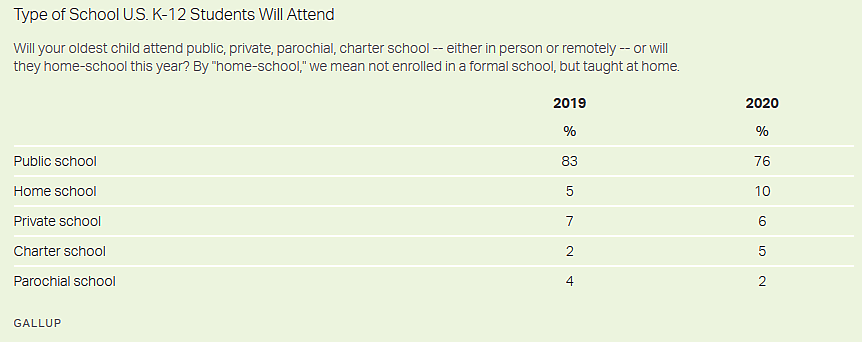Educational freedom is having a moment with COVID-19, with many parents feeling trapped by public school decisions about how to deliver instruction, and the GOP featuring school choice on the first night of its convention. Nonetheless, new data suggest COVID-19 could be crippling private schooling.
According to a new Gallup poll, between the beginning of last school year and this year the percentage of parents planning to enroll their kids in private schools dropped from 7 to 6 percent, and in parochial schools from 4 to 2 percent. Those would be huge but not totally unexpected hits to private schooling, though from an overall educational freedom perspective the news is not necessarily terrible: most of the move may be to home schooling. In 2019, 5 percent of parents said they would educate their children at home, versus 10 percent today. The percent planning to enroll in public schools dropped from 83 to 76 percent, while planned charter school enrollment increased.
We should interpret these results cautiously. First, there is a ±8 percentage point margin of error for the parent-only sample. In addition, while the enrollment question clarifies that home schooling does not just mean receiving instruction at home, it would not be surprising if many respondents did not fully absorb the distinction. Even if they did, it is unclear how many would continue to homeschool or stick with whatever options they plan to use now when the COVID threat subsides. Finally, the poll was conducted between July 30 and August 12, which may seem recent, but schools’ plans and parental concerns have been changing very rapidly. It is quite possible a lot of decisions have changed since the poll was taken.
Running in a more positive direction for private schools is that we are still seeing permanent closure announcements coming in just dribs and drabs. Since major announcements in New York City on July 9, which saw 28 closures, we have recorded only 13 closures nationwide. In total we have tracked 118 permanent private school closures at least partially driven by COVID-19. To put that in perspective, the federal government reports that there were roughly 32,000 private schools in the country as of 2017 — 118 is a tiny share of that. And anecdotal evidence suggests that many private schools are seeing increased demand as they offer in-person schooling public schools do not. That said, many private schools are very small – about a third have fewer than 50 students – and we may simply not be hearing about their closures. They may be too small for public closure announcements or media attention.
So how is COVID-19 shaking out for private schooling? We do not know with certainty, and probably will not until well into September, after school has resumed everywhere. Even then we will not know the longer-term implications of COVID-19 for private education, including homeschooling. But one thing remains clear: We would have been better off had widespread school choice been implemented long ago, and families were not largely locked in to whatever public school districts decide to offer.


